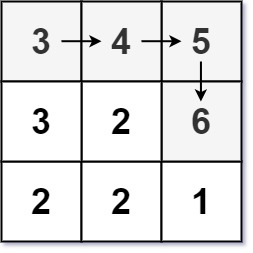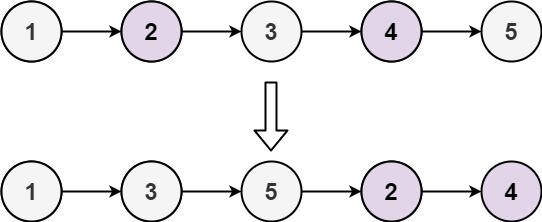Q:
Given an m x n integers matrix, return the length of the longest increasing path in matrix.
From each cell, you can either move in four directions: left, right, up, or down. You may not move diagonally or move outside the boundary (i.e., wrap-around is not allowed).
Example 1:

Input: matrix = [[9,9,4],[6,6,8],[2,1,1]]
Output: 4
Explanation: The longest increasing path is [1, 2, 6, 9].
Example 2:

Input: matrix = [[3,4,5],[3,2,6],[2,2,1]]
Output: 4
Explanation: The longest increasing path is [3, 4, 5, 6]. Moving diagonally is not allowed.
Example 3:
Input: matrix = [[1]]
Output: 1
Constraints:
m == matrix.lengthn == matrix[i].length1 <= m, n <= 2000 <= matrix[i][j] <= 231 - 1
先试试简单的dfs,记录每个点。但是这样会超时。 d*******代码如下***********
public class Solution {
public int longestIncreasingPath(int[][] matrix) {
int m = matrix.length, n = matrix[0].length;
int res = 0;
boolean A[][] = new boolean[m][n];
for(int i =0;i<m;i++)
for(int j =0;j<n;j++)
res = Math.max(res,dfs(matrix,i,j,A,matrix[i][j]-1));
return res;
}
private int dfs(int[][] matrix, int i ,int j, boolean A[][],int minValue){
int m = matrix.length, n = matrix[0].length;
if(i<0 || i >=m || j < 0 || j >=n || A[i][j])
return 0;
if(matrix[i][j]<=minValue)
return 0;
A[i][j] = true;
int l = dfs(matrix, i,j-1, A,matrix[i][j]);
int r = dfs(matrix, i,j+1, A,matrix[i][j]);
int u = dfs(matrix, i-1,j, A,matrix[i][j]);
int d = dfs(matrix, i+1,j, A,matrix[i][j]);
A[i][j] = false;
return 1+ Math.max( Math.max(l,r),Math.max(u,d));
}
}
************改进****************
每个位置记录下其最长的increasing position(starting from it) . 毕竟,我们每个点,如果再找,也只是从比其小的位置开始。
class Solution {
public:
int longestIncreasingPath(vector<vector<int>>& matrix) {
int m = matrix.size(), n = matrix[0].size();
vector<vector<int>> M(m, vector<int>(n,-1));// how many it can go up
int res = 0;
for(int i =0;i<m;i++)
for(int j =0;j<n;j++)
res = max(res, dfs(matrix,i,j,M));
return res;
}
private:
int dfs(vector<vector<int>>& matrix, int i, int j, vector<vector<int>>& M){
if(M[i][j]>0) // if already visited
return M[i][j];
int m = matrix.size(), n = matrix[0].size();
M[i][j] = 1;
if(i-1 >= 0 && matrix[i-1][j] > matrix[i][j]){
M[i][j] = max(M[i][j], 1 + dfs(matrix, i-1,j,M));
}
if(i+1 < m && matrix[i+1][j] > matrix[i][j]){
M[i][j] = max(M[i][j], 1 + dfs(matrix, i+1,j,M));
}
if(j-1 >= 0 && matrix[i][j-1] > matrix[i][j]){
M[i][j] = max(M[i][j], 1 + dfs(matrix, i,j-1,M));
}
if(j+1 < n && matrix[i][j+1] > matrix[i][j]){
M[i][j] = max(M[i][j], 1 + dfs(matrix, i,j+1,M));
}
return M[i][j];
}
};
Mistakes:



